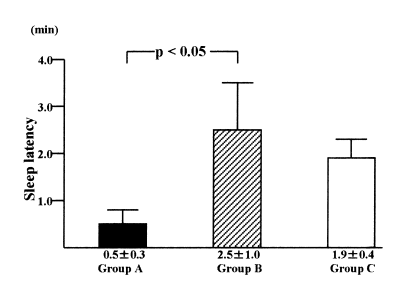Clinical significance of cataplexy and HLADR1501 in narcolepsy
Abstract
Clinical symptoms and multiple sleep latency test (MSLT) measures among narcoleptic patients with both cataplexy and HLADR1501 were compared with cataplexy-free narcoleptic patients with a positive finding of HLADR1501 and cataplexy-free patients without HLADR1501. Both mean sleep onset latencies and rapid eye movement (REM) latencies on MSLT were shorter in the patients with cataplexy compared with the cataplexy-free patients. In four cataplexy-free patients without HLADR1501, nocturnal sleep was remarkably long and their excessive daytime sleepiness did not respond to treatment. The findings suggest that the severity and disease mechanism of narcolepsy might become heterogenous when cataplexy and HLADR1501 are considered.
INTRODUCTION
Cataplexy is a well-known specific symptom in narcolepsy. It is well known HLADR1501 is a definitive immunological marker of the disorder, whereby the rate of a positive finding of HLADR1501 in Japanese narcoleptic patients is almost 100%.1 However, according to International Classification of Sleep Disorders (ICSD), the clinical diagnosis of narcolepsy can be made without the aforementioned variables when both definite excessive daytime sleepiness and more than double the appearance of sleep onset rapid eye movement periods (SOREMP) on multiple sleep latency test (MSLT) are recognized.2 Nevertheless, homogeneity of narcoleptic patients with and without cataplexy and/or HLADR1501 has not yet been studied. In order to clarify this issue, we made a comparison of the symptoms and MSLT measures between subgroups of narcoleptic patients.
SUBJECTS AND METHOD
Thirty-two untreated patients who met the ICSD criteria of narcolepsy were enrolled in the study. Patients were divided into three groups: (i) patients with cataplexy and a positive finding for HLADR1501 (group A; n = 9); (ii) cataplexy-free patients with a positive finding for HLADR1501 (group B; n = 10); and (iii) patients without both cataplexy and HLADR1501 (group C; n = 13). In order to evaluate the severity of daytime sleepiness and vulnerability to the appearance of REM sleep, standard MSLT3 were performed four times each day at 10.00 h, 12.00 h, 14.00 h, and 16.00 h. The SOREMP was determined when REM sleep appeared within 15 min after sleep onset. The frequencies of SOREMP as well as the mean latencies of both sleep onset and REM stage on MSLT were compared among the groups. Demographic variables, length of nocturnal sleep judged from a sleep log recorded for more than 2 weeks, as well as the number of the patients with hypnagogic hallucination and/or sleep paralysis, were also compared. Furthermore, response to treatment with psycho-stimulants for more than three consecutive months was evaluated in the subjects. Patients with more than a 50% reduction rate in the frequencies of daytime dozing-off per day during the follow-up period were considered to have responded to treatment. One-way ANOVA, post-hoc test, and χ2-test were employed for the analysis of statistical differences among the groups.
RESULTS
Neither gender distribution nor onset age of hypersomnia differed among the three groups. With regard to MSLT variables, mean sleep onset latencies were significantly longer in group B than group A, as shown in Fig. 1 (P < 0.05). Although frequencies of SOREMP were not different among the three groups, REM latency was significantly longer in group C compared with both group A and group B (group A, 1.3 ± 0.5 min; group B, 2.8 ± 0.7 min; group C, 4.8 ± 0.6 min; group C vs group B, P < 0.05; group C vs group A, P < 0.01, respectively). The number of patients with hypnagogic hallucination and/or sleep paralysis for each group was not different. For mean duration of nocturnal sleep, the values were not statistically different among the groups (group A, 7.0 ± 0.1 h; group B, 7.1 ± 0.3 h; group C, 8.0 ± 0.4 h); however, five patients of group C showed remarkably long sleep of more than 10 h, whereas all the patients in groups A and B showed a value of less than 9 h. In terms of the treatment outcome, four of the aforementioned five subjects were judged to be non-responders, although their mean daily dosage of psycho-stimulants was almost equivalent to that of treatment responders.

. Comparison of mean sleep latency in mean sleep latency test (MSLT) among patient groups. Group A, narcolepsy patients with cataplexy and HLADR1501 (n = 9); group B, narcolepsy patients without cataplexy who showed positive findings for HLADR1501 (n = 10); group C, narcolepsy patients without both cataplexy and HLADR1501 (n = 13). Values are expressed as mean ± SD.
DISCUSSION
Although the frequencies of SOREMP were not different among the three groups, long latency of REM stage on MSLT findings in the cataplexy-free patients might suggest that such patients are less vulnerable to SOREMP. This finding is in agreement with a previous study on the close relationship between REM sleep mechanism and occurrence of cataplexy.4 In addition, the shortest value of sleep onset latency on MSLT in patients with cataplexy might indicate that excessive daytime sleepiness and cataplexy partially share a common mechanism. When focusing on the length of nocturnal sleep and the treatment effect of psycho-stimulants on daytime sleepiness, a certain number of patients without both cataplexy and HLADR1501 showed a pattern that was different from that of other narcoleptic patients. Considering that long duration of nocturnal sleep and poor response to treatment with psycho-stimulants are the characteristics of idiopathic hypersomnia,5 we speculate that the disease mechanism in patients without both cataplexy and HLADR1501 might be heterogenous. In conclusion, the existence of both cataplexy and HLADR1501 should be emphasized in cases when diagnosing typical and homogenous patients with narcolepsy.




